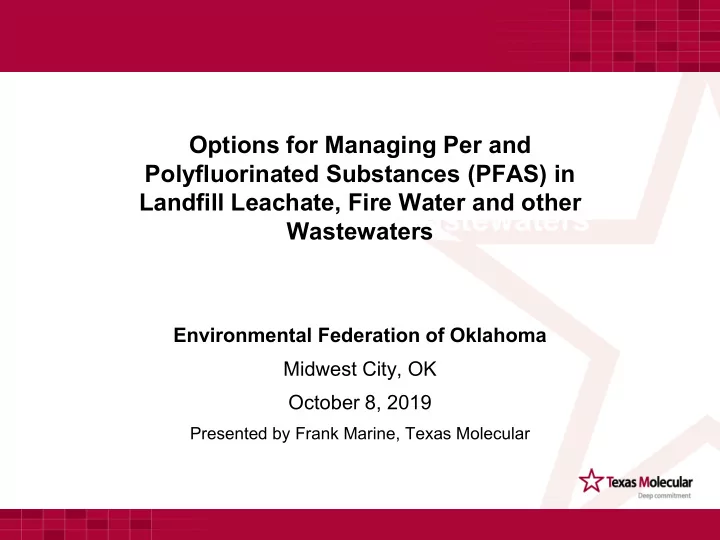

Options for Managing Per and Polyfluorinated Substances (PFAS) in Options for MaPer or Polyfluorinated Landfill Leachate, Fire Water and other Substances (PFAS) in Wastewaters Wastewaters from Plating Operations Environmental Federation of Oklahoma Midwest City, OK October 8, 2019 Presented by Frank Marine, Texas Molecular
Agenda • Regulatory Comments • Sources of PFAS Liquids • Options to Manage PFAS Liquids • Options to Manage PFAS Treatment Residuals • Considerations for Selecting an Option • References • Questions
Regulatory Comments • Regulations are changing and can be retroactive. » Regulations started with PFOA and PFOS; Other PFAS compounds are now being considered » EPA Health Advisory of 70 ppt was >200 about 10 years ago; There is no certainty what it will be in the future and what PFAS compounds will be included » Use of PFAS in mist suppression in Chromic Acid plating was encouraged/mandated; Now these products are banned from use; These sites now have legacy contamination clean-up issues » Industry eliminated production of C8 PFAS and went to “safer” C6 PFAS. Some of these compounds are coming under scrutiny and actual regulation in many jurisdictions • PFAS found in drinking water is driving State regulations and increased level of testing across the country • Although the EPA is not likely to list PFAS as a Hazardous Waste, they are more likely to be added to Hazardous Substances list under CERCLA, adding reporting and structure to legacy clean up • Unregulated Contaminant Monitoring Rule (UCMR) is expected to add more PFAS compounds when finalized
Sources of PFAS Liquids • Chemical production at facilities manufacturing fluorinated compounds using PFAS or PFAS intermediates • Secondary facilities that use compounds with PFAS in the products like coated paper mills, textile plants, lubricants, cosmetics, etc. • Landfill leachate from Non-Hazardous Subtitle D landfills. Potential high concentrations from years of taking products with PFOA, PFOS, and other PFAS • Facilities that make, use, or test AFFF fire fighting foams; Users include airports, US Military, airlines, chemical plants, storage terminals, and petroleum refineries; Contamination potential in ground, groundwater, and water collected after use • Legacy contamination from sites using PFAS including plating facilities www.texasmolecular.com
Options to Manage PFAS Liquids • Ion Exchange Resin (IX) • Granular Activated Carbon (GAC) • Reverse Osmosis (RO) • Deepwell Injection • Landfills • Other Technologies
Options to Manage PFAS Liquids Ion Exchange Resin Advantages Disadvantages • Fully demonstrated • Regeneration fluid or single technology with targeted use requires off-site resins for PFAS disposal or incineration • Generally higher adsorption • Multiple species of capacity than GAC contaminents can reduce efficiency • Scalable, capable of managing large water • May not remove all PFAS volumes compounds • Can be used in combination • How clean is “clean” with GAC
Options to Manage PFAS Liquids Granular Activated Carbon (GAC) Advantages Disadvantages • Demonstrated option for • Break through risk PFAS removal • Requires regeneration or • Better for PFAS with greater incineration of spent GAC than 6 carbon atoms • Multiple species can reduce • Scalable, can manage large efficiency of GAC volumes of water • Source of GAC is important • Can be used with other technologies
Options to Manage PFAS Liquids Reverse Osmosis (RO) Advantages Disadvantages • A developed technology to • High concentration RO remove PFAS from water reject stream may require off-site treatment • Scalable, can manage large volumes of water • Non-target compounds may increase corrosivity • May be better for 6 carbon chain PFAS
Options to Manage PFAS Liquids Hazardous Underground Injection Advantages Disadvantages • No discharges to water • Transportation cost to disposal site • Meet potential regulation as a hazardous waste or • Potentially cost effective in hazardous substance today up to 5 to 10 million gallons per year • Constituent level and variety are generally not an issue • Water properties should be amenable to underground • Large capacity injection • No CAPEX • Lower cost vs. incineration
Options to Manage PFAS Liquids Landfill Advantages Disadvantages • Locations near generating • Risk to PFAS in landfill sites could result in overall leachate lower off-site cost • Limits on volume of water waste • Risk of future regulation
Options to Manage PFAS Liquids Other Options • Biochar- Partially demonstrated technology • Other absorption technologies- Partially developed • Precipitation, Flocculation, Coagulation- Lab/bench scale testing • Nanofiltration- Partially developed • Redox Manipulation - Lab/bench scale testing • “Necessity is the Mother of Invention” New technologies are being developed at a number of universities and private companies
Options to Manage PFAS Liquids Treatment Residues • Ion Exchange Resins » Single Use- Incineration in RCRA Incinerator » Regeneration Residue- Incineration in a RCRA Incinerator or injection in an Underground Injection facility • Granular Activated Carbon » Regeneration » Single Use- Incineration in a RCRA Incinerator • Reverse Osmosis » RO Reject Stream- Incineration in RCRA incinerator or injection in an Underground Injection facility
Considerations for Selecting an Option • Volumes: > 5 million gallons/year generally favor on-site options < 5 million gallons/year or discrete projects ; Off-site options may become competitive • Distance to off-site options. Is truck or rail available • Concentrations: High concentrations ; Adds to cost for on-site options • Segregate sources of high PFAS to utilize multiple strategies • Contaminents: Multiple or variable contaminant levels can add to cost of on-site options. Technology may not be effective on all types of PFAS • Risk of Future Regulations Does the technology meet potential future regulations • Discharge Risk: Off-site options are considered on a cost/benefit basis
References • Interstate Technology Regulatory Council, ITRC. https://www.itrcweb.org/wp- content/uploads/2018/03/pfas_fact_sheet_remediation_3_13_18.pdf • National Association for Surface Finishing, NASF https://nasf.org/pfas/pfas-in-surface-finishing/ • USEPA. EPA’s Per- and Polyfluorinated Substances (PFAS) Action Plan, EPA 823R18004, February 2019 • Association of State Drinking Water Administrators (ASDWA) www.asdwa.org/PFAS
Recommend
More recommend